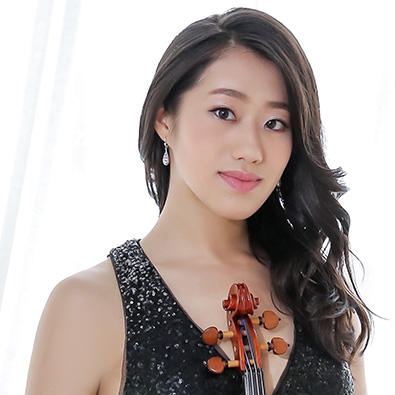Marsalis’ “Fiddler’s Tale” proves an unconvincing Stravinsky mashup

Beatrice Hsieh was the violin soloist in Wynton Marsalis’ A Fiddler’s Tale Sunday at New World Center.
Wynton Marsalis is one of the greatest jazz trumpet players in recent decades. His skill has extended to playing and recording classical trumpet concertos, winning praise from critics and listeners. As director of the Jazz at Lincoln Center Orchestra, he has played a major role in preserving the legacy of composers and arrangers of the big band era.
His forays into classical composition, however, have yielded less satisfying results. That was all too painfully evident at the New World Symphony’s presentation of Marsalis’ A Fiddler’s Tale on Sunday afternoon at the New World Center in Miami Beach.
Conceived as a companion piece to Stravinsky’s L’Historie du Soldat (A Soldier’s Tale), Marsalis’ score utilizes the same instrumentation as Stravinsky’s and, likewise, features a narrator to recite the story and play some of the characters.
Both works tell the story of a Faustian bargain by the protagonist with the devil in search of some greater reward. In this version of Marsalis’ piece, Beatrice Connors, a violinist unhappy with her band, seeks greater artistic freedom and fame. The devil Bubba Z. Beals rechristens her “The Beacon with the Bow” and brings her millions of fans. Unhappy with facile but unrewarding success, Connors ventures south, seeking a savior to reclaim her soul. She meets and reunites with her old band only to have Beals take it over and rush her away, claiming his price.
The text by poet, jazz and social critic Stanley Crouch is clever but over-verbose, sometimes employing vernacular dialect and colloquialisms. While Stravinsky’s work is a masterpiece of neo-classicism, Marsalis’ score is an uneasy blend of contemporary harmonies and New Orleans jazz bereft of the distinction of either style at their best. “The Fiddler’s March,” which is repeated numerous throughout the 67-minute opus is weakish pseudo-jazz. Pastorale and dawn music emerge bland. In the composition’s longest sustained musical segment, Marsalis scores the same three dances that Stravinsky created in his piece—a tango, waltz and ragtime. This tuneful pastiche is the best music in the setting.
Marsalis’ writing for the protagonist merges country style fiddling and the blues. New World fellow Beatrice Hsieh played with bravura exactness, cascading slides and rich vibrato. She is clearly an outstanding musician who deserved better material to display her considerable dexterity.
Kenneth Chauby’s brilliant trumpet riffs in the dances were a standout and Brendon Sill brought agile musicality to the tricky bassoon part. Sunho Song’s high clarinet leaps added some zest to the proceedings. Graham Mynatt on trombone and Jakob Gerritsen on bass (plucking in jazz fashion rather than bowing) contributed to the deft ensemble. Jennifer Marasti was the busy, rhythmically acute percussionist. Finnish conductor Kasmir Uusitupa kept a tight rein on the ensemble, bringing out the best elements of Marsalis’ writing.
Theater, film and television actor Nic Few was a genial narrator, switching into high-voiced falsetto for the words of the devil. At the conclusion, Few pushed Uusitupa off stage and led the players himself (signifying the devil’s taking charge of the band) while swaying his legs and hips. After he removed Hsieh from stage, the musicians continued playing for a while with each leaving one at a time. Finally, Marasti and Gerritsen were left alone to finish in partial darkness.
The performance was accompanied by photos selected by artist Gary Simmons, projected on screens behind the players. Pictures from the dark times of the Jim Crow South (with “Whites Only” or “Colored” signs on building doors) and scenes of crowded discos were eye-filling but what did they have to do with Marsalis’ scenario? The best visual element was swirling designs on the hall’s walls during the dances, suggesting ballroom.
With its adjustable stage and seating and video capabilities, the New World Center is the ideal setting for a full-scale production of Stravinsky’s Soldier’s Tale. It is a long time since the orchestral academy devoted its resources to such a project rather than this half-baked attempt at an uneasy classical-jazz fusion.
Lina González-Granados conducts the New World Symphony in Iman Habibi’s Jeder Baum sprecht, Alberto Ginastera’s Harp Concerto, Henri Tomasi’s Trumpet Concerto and Erich Wolfgang Korngold’s Violin Concerto with soloists Abigail Kent (harp), Kenneth Chauby (trumpet) and Beatrice Hsieh (violin) 8 p.m. April 13 and 2 p.m. April 14 at the New World Center in Miami Beach. nws.edu
Posted in Performances
Leave a Comment
Mon Mar 25, 2024
at 12:01 pm
No Comments





